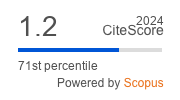Vowel Phonemes in Hindi
DOI:
https://doi.org/10.29038/eejpl.2018.5.2.bshKeywords:
consonants, diphthongs, Hindi, meaning, monophthongs, vowel phonemes.Abstract
An analysis of the present day Hindi, as spoken in the northern part of India, brings to light the fact that this language has at least twenty vowel phonemes, and not simply thirteen. Twelve of these twenty vowel phonemes are oral while eight of them are nasalized. Eighteen of them are pure vowels (monophthongs) while two of them are diphthongs. Two of the thirteen vowels included in the current list of alphabet have given place to two consonants with the result that they have ceased to exist. Most of these vowel phonemes occur in all the three positions, namely initial, medial and final, in the Hindi words.
References
- Agnihotri, Rama Kant. (2007). Hindi: An Essential Grammar. London: Routledge.
- Chatterjee, Suniti Kumar. (1942). Indo-Aryan and Hindi: Eight Lectures. Ahmedabad: Gujarat Vernacular Society. Retrieved from: https://archive.org/details/in.gov.ignca.2478.
- Duncan Forbes. (1846). A Grammar of the Hindustani Language in the Oriental and Roman Character, London: W. H. Allen & Co. Retrieved from: https://ia801408.us.archive.org/ 27/items/agrammarhindstn00forbgoog/agrammarhindstn00forbgoog.pdf.
- Dwivedi, Kapildev. (2016). Bhasha Vigyan Evam Bhasha Shastra [Philology and Linguistics]. Varanasi: Vishvavidaya Prakashan.
- Greaves, Edwin. (1921). Hindi Grammar. Allahabad: Indian Press.
- Guru, Kamta Prasad. (2009 rpt. [1920]). Hindi Vyakaran [Grammar of Hindi]. New Delhi: Prakashan Sansthan.
- Koul, Omkar N. (2008). Modern Hindi Grammar. Springfield: Dunwoody Press.
- Pahwa, Thakardass. (1919). The Modern Hindustani Scholar; or, The Pucca Munshi. Jhalum: Printed at the Baptist Mission Press, Calcutta and published by the author.
- Shakespear, John. (1845). An Introduction to the Hindustani Language. Comprising a Grammar, and a Vocabulary, English and Hindustani. London: Wm. H. Allen & Co. Retrieved from: https://archive.org/details/introductiontohi00shakrich.
- Sharan, Ram Lochan. (1920). Hindi Vyakaran Chandrodaya [Chandrodaya Hindi Grammar]. Darbhanga: Hindi Pustak Bhandar.
- Sharma, Aryendra. (1994). A Basic Grammar of Hindi. Delhi: Central Hindi Directorate.
- Tiwari, Bhola Nath. (1958). Hindi Bhasha ka Saral Vyakaran [A Simple Grammar of Hindi]. Delhi: Rajkamal.
- Tiwari, Uday Narayan. (2009). Hindi Bhasha ka Udgam aur Vikas [Origin and Development of Hindi Language]. Allahabad: Lok Bharati, 2009.
- Tweedie, J. (1900). Hindustani as It Ought to be Spoken. London: W. Thacker. Retrieved from: https://archive.org/details/hindstniasitoug00tweegoog/page/n6.
- Verma, Ram Chandra. (1961) Manak Hindi Vyakaran [Standard Grammar of Hindi]. Varanasi: The Chaukhambha Vidya Bhawan.
Sources
- www.wikihow.com/Learn-Hindi
- https://en.wikipedia.org/wiki/Devanagari
Downloads
Download data is not yet available.
Downloads
Published
2018-12-28
Issue
Section
Vol 5 No 2 (2018)
How to Cite
Brahma Dutta Sharma. (2018). Vowel Phonemes in Hindi. East European Journal of Psycholinguistics , 5(2), 71-91. https://doi.org/10.29038/eejpl.2018.5.2.bsh











 Creative Commons «Attribution» 4.0
Creative Commons «Attribution» 4.0